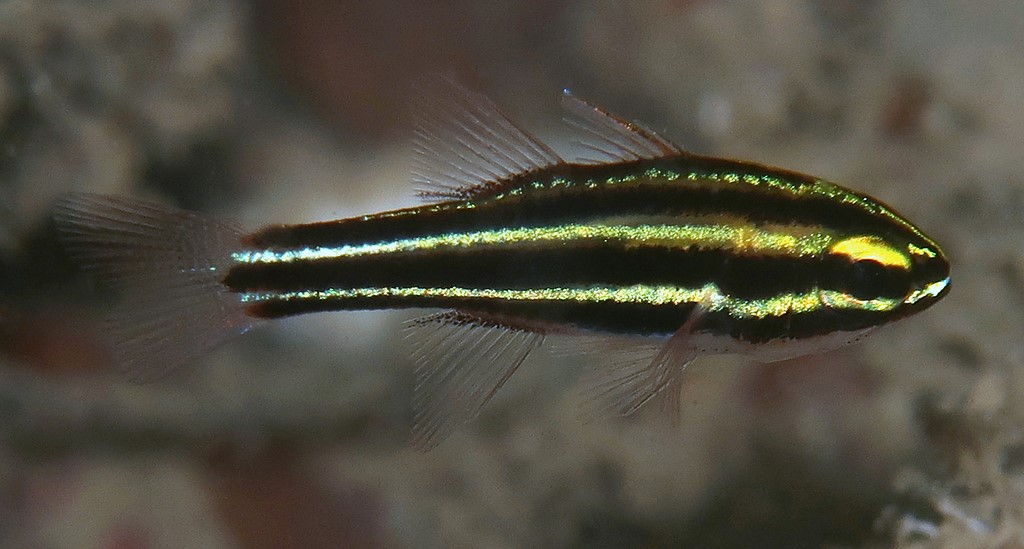OSTORHINCHUS NIGROFASCIATUS - (LACHNER, 1953)
Picture courtesy of: Alain Daoulas
Apogon à rayures noires, Black-striped cardinalfish, Blackstriped cardinalfish, Blackbanded soldierfish, Blackstripe cardinalfish, Gestreifter Kardinalfisch, Pesce cardinale, Minami-futosuji-ishimochi, ミナミフトスジイシモチ, 大目側仔, 黑帶天竺鯛,
Synonyme
Apogon nigrofasciatus (Lachner, 1953)
--------------------------
Description
Dorsal spines (total): 7; Dorsal soft rays (total): 1 spine, 9 rays; Anal spines: 2; Anal soft rays: 8; Pectoral fin rays: 13-14; Pelvic fin rays: I, 5; Last ray of second dorsal fin and anal fin not elongate. Pored lateral line scales: 24; Median predorsal scales: 3-5 (usually: 4); Circumpeduncular scales: 12; Total gill rakers: 24, developed gill rakers: 18; Snout pointed; Villiform teeth on premaxillae and dentaries, and in 1-2 rows on vomer and palatines. Greatest depth of body: 2.6-3.1 in SL. Max. length: 14.0 cm TL, common length: 9.0 cm SL. Depth range: 3 - 50 m.
Color
Head and body with 5 dark stripes and pale interspaces of similar width (first dark stripe from interorbital region to beneath second dorsal fin; Second from top of snout, over eye, and dorsolaterally on body to caudal fin base; Third from snout, through eye, above pectoral fin base and midlaterally to caudal fin base, with slightly expanded basicaudal spot-like area; Fourth from lips, below eye, through part of pectoral fin bases and abdomen to caudal-fin base; Fifth from lower jaw to pelvic fin base and anal fin); All fins pinkish.
Etymology
Ostorhinchus: from Greek, osteon = bone + from Greek, rhynchos = beak. In reference to the bony jaws, very much advanced and jagged, which take the place of the teeth.
nigrofasciatus: from Latin, nigro = black + from Latin, fascio = I envelop with bands, swathe. Referring to five horizontal black stripes.
Original description: Apogon nigrofasciatus Lachner, 1953 - Type locality: Yuro Island, Bikini Atoll, Marshall Islands, western Pacific.
Distribution
Red Sea; Indo-West Pacific: East Africa, Comoros, Madagascar and Maldives, east to Marshall Islands and Tuamotu Archipelago (French Polynesia), north to southern Japan, south to Western Australia, Queensland (Australia), Elizabeth Reef (Australia), New Caledonia, Tonga and Rapa (French Polynesia).
Biology
Occurs on reef flats and shallow lagoon reef, usually seen singly or in pairs under ledges or in crevices. Feed on small benthic invertebrates at night. Mouthbrooders. Distinct pairing during courtship and spawning.
Similar species
Ostorhinchus angustatus (Smith & Radcliffe, 1911) - Reported from New Caledonia - Link to the species (here). The blackish stripes on the head and body of Ostorhinchus angustatus are crisp, about the same width as the whitish stripes and there is a dark basicaudal spot.
Ostorhinchus novemfasciatus (Cuvier, 1828) - Reported from New Caledonia - Link to the species (here).
Ostorhinchus regula (Fraser & Randall, 2003) - Reported from Western Pacific: Mariana Islands and Caroline Islands. Alternating golden-brownish and white stripes on head and body in life, broad dark brown stripes on upper and lower caudal peduncle, midlateral stripe without a developed spot, whitish stripe extending onto last 2 anal rays; Elongated last dorsal and anal rays; 12-13 circumpeduncular scales; 13-14 well developed gill rakers on first gill arch. Depth range: 30 - 60 m.
Last update: 6, May 2024
Ostorhinchus regula (Fraser & Randall, 2003) - Reported from Western Pacific: Mariana Islands and Caroline Islands. Alternating golden-brownish and white stripes on head and body in life, broad dark brown stripes on upper and lower caudal peduncle, midlateral stripe without a developed spot, whitish stripe extending onto last 2 anal rays; Elongated last dorsal and anal rays; 12-13 circumpeduncular scales; 13-14 well developed gill rakers on first gill arch. Depth range: 30 - 60 m.
Last update: 6, May 2024
